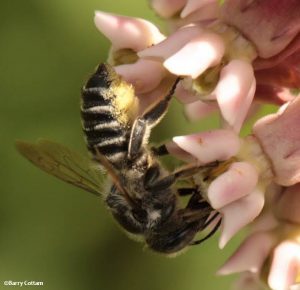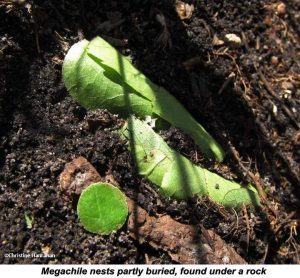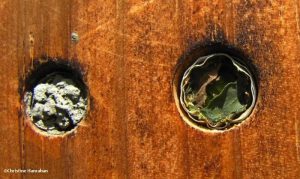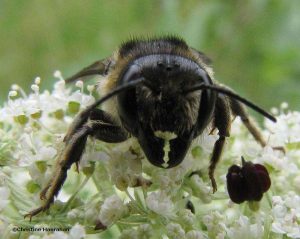by Sandy Garland
If you discover plants or trees in your garden with perfect circles cut out of the leaves, please celebrate – you have leafcutter bees living close by. Seeing them at work cutting those circles or flying with a rolled-up piece of leaf is a real treat.

A Leafcutter Bee on Common Milkweed flowers. As you can see, these bees carry pollen on their abdomen, in contrast to most bees who carry it in pollen sacs on the legs. Photo taken by Barry Cottam at the Fletcher Wildlife Garden
The family Megachilidae (leafcutter bees), includes a variety of genera, but the ones we are most familiar with are those in the genus Megachile, which are very common in our region.
Leafcutters are medium-sized bees (about the size of a honeybee). Their distinctive feature is a yellow “stomach,” usually coated with pollen (see photo at right).
These bees have only one generation a year and live for only a short time. The adults emerge from their overwintering site in June, mate, gather nectar and pollen and build elaborate apartments of leaf discs in dead stems or other tunnels or tubes.
Christine Hanrahan has reported, “Most of the ones [leafcutter nests] I found were under rocks, but they could equally be in rotting wood, in tunnels in the ground, in and around human made objects such as pipes, under bricks, or, as at FWG, in bee boxes.”
 Each room – which is constructed of up to 15 leaf discs chewed at the edges so that they stick together – contains an egg, laid on a ball of nectar-pollen mix. The eggs hatch in about a week and the larvae feed on the meal their mother has left for them. By now most of the adults have died, having completed their life cycle.
Each room – which is constructed of up to 15 leaf discs chewed at the edges so that they stick together – contains an egg, laid on a ball of nectar-pollen mix. The eggs hatch in about a week and the larvae feed on the meal their mother has left for them. By now most of the adults have died, having completed their life cycle.
Meanwhile, inside the “apartments,” the bee larvae have finished consuming their meal and are large enough to fill their room. They transform into pupa and “sleep” for the rest of the year, getting ready to emerge as adults the following June.
How to help

The tunnel on the left has been used by a mason bee, the entrance packed with clay. On the right, is the nest of a leafcutter bee, the entrance plugged with leaves. Photo by Christine Hanrahan, August 2012, Fletcher Wildlife Garden
Leafcutters use thin, non-hairy leaves, such as those from plants in the rose family (including roses, mountain ash, hawthorns, plums, cherries), but we’ve also noticed them using maple leaves and some may use petals. Don’t be alarmed if you see this leaf “damage” in your garden. The bees will not kill the plants and the cutting period is only a few weeks long.
Leafcutters are among the small proportion of native bees that nest above ground. They seem to prefer tunnels that are about 5-7 mm in diameter. At the Fletcher Wildlife Garden we’ve had great success with holes drilled into a block of wood, but leafcutters have not used the artificial tunnels of rolled paper that we make for Mason Bees (see Bee box workshops).
Leafcutter bees found at the FWG
Heriades carinatus
Hoplitis pilosifrons
Hoplitis producta
Megachile brevis
Megachile centuncularis
Megachile frigida
Megachile gemula
Megachile inermis
Megachile latimanus
Megachile relativa
Megachile rotundata (non-native, according to Wikipedia, “introduced for crop pollination”)
Further reading
Busy leafcutter bees (July 2019) – blog post by Berit Erickson, with photos and videos showing nest sites and bees at work
Leafcutter Bees at the FWG by Christine Hanrahan – first-hand experience and excellent photos
The Leafcutter Bee from Buzz About Bees – includes videos of leaf cutting and a bee building in a plant stem
Megachile at BugGuide – comprehensive information about leafcutters and other members of the Megachile genus
Sandy Garland is a long-time volunteer at the Fletcher Wildlife Garden. She became interested in bees and other pollinators when she built an insect hotel and, around the same time, started photographing bumble bees to submit to Bumble Bee Watch.

Oh I hope I have not seriously disturbed a nest I found!! I thought it was a Horsefly nest, and I hate them, so I was going to destroy it all, but realized after removing the rock and slightly unraveled one little bundle, I wasn’t so sure anymore that it was what I thought! I placed the two that were moved, as I picked one of the bundles up to have a closer look, and all were placed back in their spots, and re-covered with the rock! This page was where I came to afterwards to find out exactly what it was! I’m hoping they will survive!! Any pollinator is a welcome one around my home!!
Flies lay eggs on leaves or other structures out in the open. They don’t build “nests.” Quite good information about Horse and Dee flies here – https://extension.entm.purdue.edu/publichealth/insects/tabanid.html